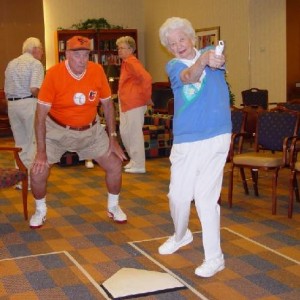AAA (updated)

 *Mea cupla: Wasn’t accurate in my original post. Should be accurate now.
*Mea cupla: Wasn’t accurate in my original post. Should be accurate now.
Last week I had the opportunity to chat with some of the folks who work in the Triangle J Area Agency on Aging. The Area Agency on Aging, or AAA, is one of the COG’s largest and oldest programs. The AAA exists for a myriad of reasons: To provide care for older adults; to create and sustain a system of supports and services that enable older adults to live as independently as possible; and to develop resources and outlets for health and independent older adults.
The organization’s scope is vast, so I’ll limit my post to some of the high points. (For more info, follow the links at the bottom of the post. Also, the people below me are playing the Wii!)
Funding for AAA programs works like this:
The Feds allocate money to each state based on the number of elderly residents. The state then cuts checks to each COG based on the number of elderly residents in its region (The actual funding formula is complicated.) The AAA program administrators disperse that money to each county, and monitor how each county spends it. Jurisdictions have freedom to spend it on a select number of services such as home-delivered meals, adult day care or transportation for older residents.
The majority of the funding comes from a Home and Community Care Block Grant, which is mandated under the Older Americas Act of 1965 (LBJ in the house!). The state could send checks directly to the counties, but it’s more efficient to let COGs distribute the (pass-through) dollars and oversee how they are spent.
The AAA gets additional portions of funding to pay for a few small programs such as the Caregivers Support Program and the Ombudsman Program. The Caregivers Support program, which provides information and assistance to families who are living with elderly family members, is administered at the regional level so the Caregiver Support Program coordinator can help jurisdictions increase their capacity to support caregivers.
The program coordinator – in addition to baking delicious muffins for our staff meetings – works with health care providers, hospitals and even churches to create news ways to support caregivers. They may get help finding a support group or information about services. The idea here is to help older residents receive care in their home instead of being sent to a long-term care facility and becoming more dependent on state and federal tax dollars.
Some funding is also used for the AAA ombudsman program. The AAA has five ombudsmen who act as advocates for the residents of long-term care facilities. The ombudsmen investigate complaints, provide information about the AAA’s programs and work to increase awareness of issues such as elder abuse.
Services like these will be increasingly important in the future, as we will soon face what UNC-CH Business Professor Dr. James Johnson calls the “Silver Tsunami,” the large number of Baby Boomers who will be reaching old age in the next decade. More on that later.
For more on the TJAAA, check out: http://www.tjaaa.org/



One Response to “AAA (updated)”
Mary Warren
Although the Area Agencies on Aging may appear to exist so that vulnerable older adults can be appropriately “cared for”, I think it is important to note that our purpose is much broader than care. We exist to develop and sustain a system of supports and services that enable older adults to live their lives as fully and independently as possible. We work just as much to develop resources and outlets for healthy and independent older adults, as we do to facilitate appropriate care for those who are in need.